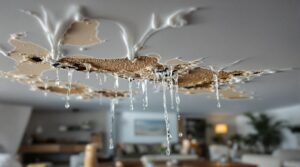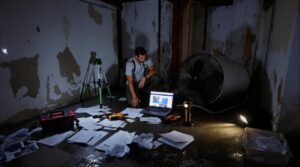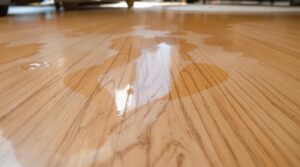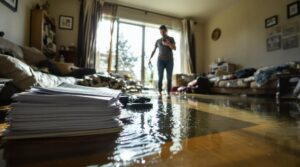Drying water under tiles requires systematic assessment and targeted intervention. Initial signs include loose tiles, discoloration, and hollow sounds when tapped. Professional moisture meters can locate concentrated areas of water accumulation. The drying process involves removing standing water with suction tools, positioning industrial fans, and using dehumidifiers for complete moisture elimination. While DIY methods exist, extensive damage may require professional expertise to prevent long-term structural issues and guarantee proper restoration.
Key Takeaways
- Remove standing water using specialized water suction tools and remove affected tiles to access trapped moisture underneath.
- Position industrial fans and dehumidifiers strategically around the affected area to promote airflow and evaporation.
- Use moisture meters to monitor drying progress and identify areas that require additional attention.
- Allow sufficient drying time of 2-5 days while continuously adjusting equipment position for optimal moisture elimination.
- Consider professional intervention for extensive damage, as they have specialized equipment and expertise for thorough drying.
Signs of Water Trapped Under Tiles
The presence of water trapped under tiles can manifest through several distinct indicators that property owners should monitor.
Visual signs of water damage include loose or tenting tiles, discoloration in both tiles and grout lines, and the appearance of efflorescence, which occurs when minerals surface due to water absorption. Immediate sealing of grout helps prevent moisture from penetrating the tile surface and causing damage.
Physical manifestations of compromised tile maintenance include soft or spongy areas in the flooring, tiles that produce hollow sounds when tapped, and noticeable movement when pressure is applied.
Professional assessment tools such as moisture meters and thermal imaging cameras can confirm suspected water intrusion.
Additionally, cracked grout lines and bulging or warped tiles often indicate significant water accumulation beneath the surface, requiring immediate attention to prevent further deterioration of the subfloor structure.
Locating the Water Source
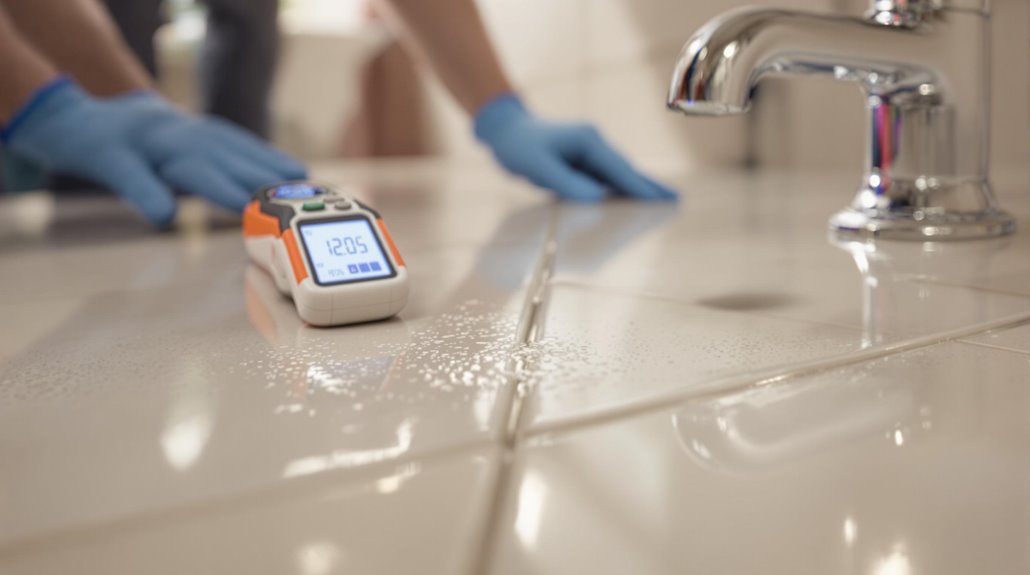
The first step in addressing water under tiles involves systematically inspecting common leak points such as plumbing fixtures, pipe connections, and grout lines.
Visual inspection should focus on identifying signs of seepage, including water stains, efflorescence on grout, or moisture accumulation at tile joints.
Professional-grade moisture meters can precisely locate concentrated areas of water accumulation and help trace the path back to the source of the leak.
Check your water meter reading for continuous spinning when no water is being used, as this indicates an active leak beneath the tiles.
Check Common Leak Points
Before addressing water under tiles, locating the source of moisture becomes essential for effective remediation. A systematic inspection of common leak points helps identify the root cause and supports proper moisture management.
Key areas to examine include plumbing fixtures, pipe connections, and aging infrastructure that may have developed cracks or corrosion. Temperature fluctuations can create expanding tile gaps that allow water seepage.
Foundation issues require particular attention in leak prevention, as structural cracks and poor exterior sealing can allow water infiltration.
Installation-related problems, such as deteriorated grout lines or inadequate waterproofing, often contribute to moisture accumulation beneath tiles.
Professional moisture meters can detect hidden water presence, while visual inspection may reveal signs like loose tiles, discolored grout, or musty odors indicating water damage.
Regular maintenance and prompt repairs of identified issues help prevent further water intrusion.
Visual Signs of Seepage
Identifying visual indicators of water seepage beneath tiles requires systematic observation of key warning signs. During seepage detection, inspectors look for discoloration, mould growth, and warping or buckling of tiles.
Drummy tiles that produce hollow sounds when tapped indicate potential water accumulation underneath.
A thorough moisture assessment reveals several critical indicators: cracked or loose tiles, deteriorating grout lines, and musty odors emanating from the affected area.
Advanced water damage manifests through extensive mould growth, structural compromises, and floor instability.
Signs requiring immediate professional intervention include standing water beneath tiles, widespread grout deterioration, and significant floor unevenness.
Regular inspection of these visual markers helps prevent extensive damage and guarantees timely remediation of waterproofing issues.
Testing With Moisture Meters
Once visual signs indicate possible water issues, moisture meters provide precise data to confirm suspicions and locate water sources beneath tiles. Proper moisture meter calibration and reading interpretation require understanding specific material baselines and meter limitations.
| Meter Type | Best Application | Key Advantage | Limitation |
|---|---|---|---|
| Pin-Type | Wood surfaces | Direct contact | Creates holes |
| Pinless | Various materials | Non-destructive | Surface only |
| Depth-Reading | Concrete slabs | Multiple depths | Cost |
| Combination | Mixed materials | Versatility | Complex setup |
Technicians must consider multiple factors when testing, including tile composition, substrate material, and environmental conditions. Readings near edges require careful interpretation due to potential false positives. For accurate assessment, moisture readings should be taken at multiple points and depths, particularly in areas showing visual deterioration or suspected water intrusion.
Essential Tools and Equipment
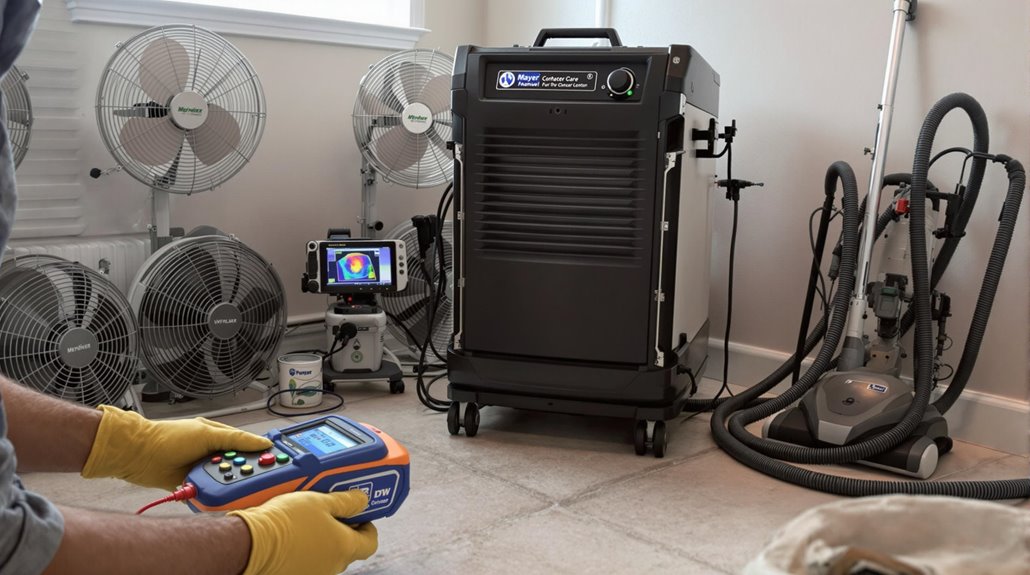
To effectively dry out water under tiles, having the right combination of tools and equipment is essential for success. The primary drying techniques require specialized equipment including fans, dehumidifiers, and wet vacuums to remove moisture and facilitate evaporation.
Equipment maintenance is critical for ideal performance during the drying process.
Moisture detection tools play an important role in monitoring progress. Devices like the Protimeter MMS2 and Tramex Moisture Encounter provide accurate measurements of subsurface moisture levels.
Thermal cameras can identify hidden water pockets, while hygrometers track ambient humidity.
For severe cases, restoration tools such as tile removal equipment and grout saws may be necessary.
Professional services offer specialized drying equipment and expertise when standard solutions prove insufficient.
Equipment rental services provide access to industrial-grade dehumidifiers and blowers for larger projects.
Professional Vs DIY Assessment
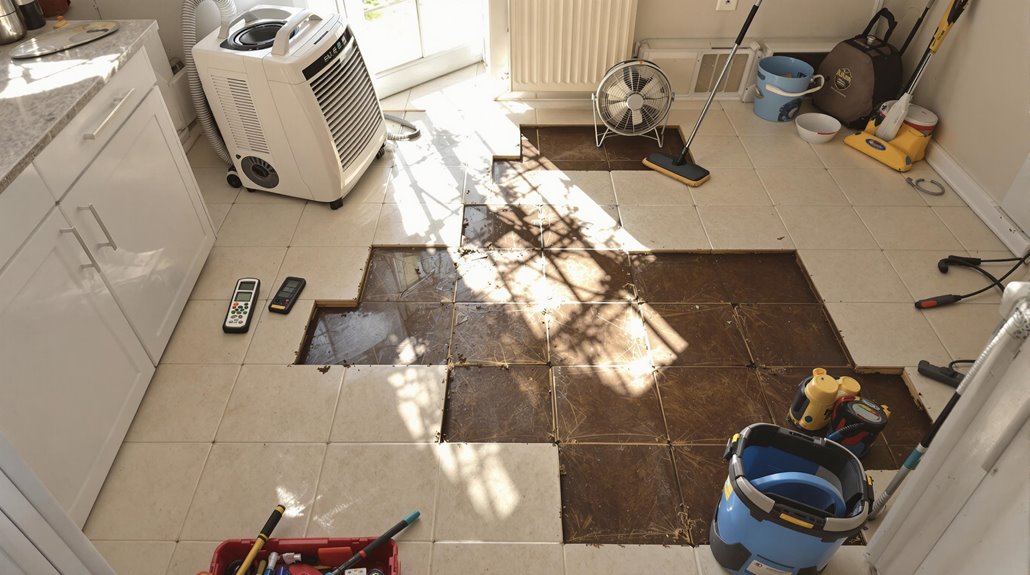
The decision between professional and DIY water damage assessment hinges on three key factors: cost implications, access to specialized equipment, and risk severity.
Professional services typically range from $500-$3000 with 2-5 days completion time, while DIY methods cost $50-$200 but may extend to 7-10 days without proper equipment.
Risk assessment guidelines indicate that extensive damage, contaminated water, or structural concerns require professional expertise, while minor surface moisture can be effectively managed through DIY methods.
Costs and Time Comparisons
When deciding between professional and DIY water damage restoration for tiles, understanding the cost and time implications is essential. A cost analysis reveals professional services range from $150 to $500 for minimal damage, while DIY approaches may require $200-500 for materials plus equipment rental fees of $20-50 daily.
Regarding time efficiency, professionals can complete drying in approximately three days, while DIY methods often extend beyond a week.
- Professional costs increase with water type: clean ($3-4/sq ft), gray ($4-6.50/sq ft), and black ($7-7.50/sq ft)
- DIY efforts risk hidden costs from potential mistakes or inadequate drying
- Professional services include specialized equipment and moisture monitoring
- Time delays in water removal greatly increase restoration costs and damage potential
Expertise and Equipment Access
Beyond financial considerations, a stark contrast exists between professional and DIY approaches in both available equipment and technical expertise for water damage restoration under tiles.
Professionals utilize high-definition cameras, specialized drying equipment, and advanced moisture meters to accurately assess and address water damage. These professional techniques, combined with extensive knowledge of industry standards, enable precise identification of moisture sources and targeted drying solutions.
DIY efforts are considerably limited by restricted access to advanced equipment, typically relying on basic tools like garden hoses and waterproof sealants.
While these methods might address minor issues, they often fall short in detecting deep-seated moisture problems or implementing thorough drying solutions. The precision and effectiveness of professional interventions, supported by moisture monitoring devices and specialized drying systems, typically deliver more reliable and lasting results.
Risk Assessment Guidelines
Professional risk assessment protocols establish clear distinctions between expert evaluations and DIY approaches in water-damaged tile situations. A thorough damage evaluation requires specialized knowledge and equipment to accurately assess moisture levels, structural integrity, and potential health hazards.
Key risk assessment considerations include:
- Moisture penetration depth and spread beneath tiles
- Subflooring stability and material degradation
- Presence of harmful contaminants or mold growth
- Long-term structural implications if left untreated
While DIY assessments may identify surface-level issues, they often fall short in detecting concealed damage patterns and safety concerns.
Professional evaluations utilize advanced moisture detection tools, thermal imaging, and standardized protocols to create extensive remediation strategies. This systematic approach helps prevent overlooked damage that could lead to costly repairs or health risks in the future.
Step-by-Step Drying Process
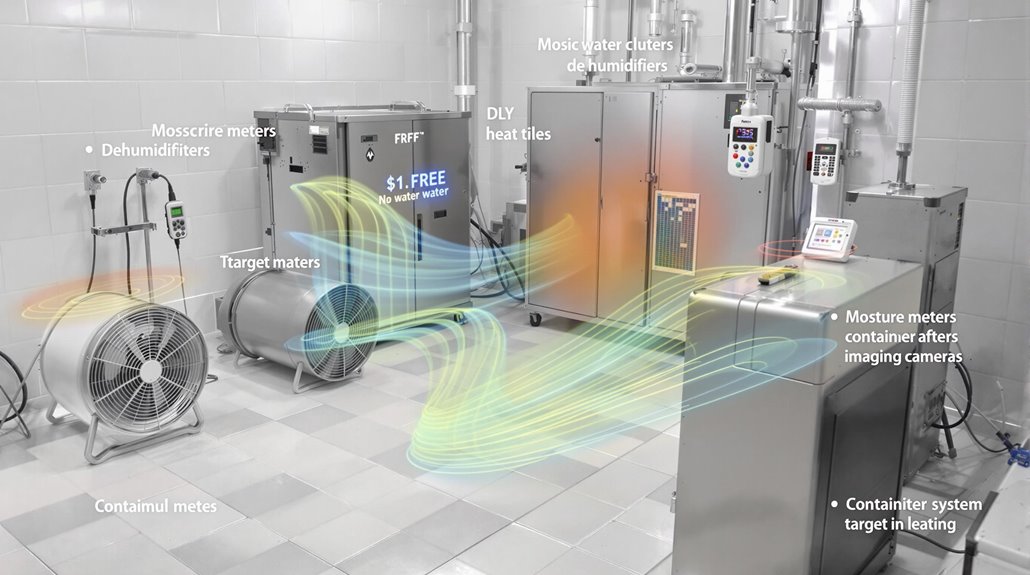
Drying water under tiles requires a systematic approach to prevent long-term damage and mold growth. The process begins with a thorough assessment of water damage and identification of the water source.
After implementing safety measures, industrial fans and dehumidifiers are strategically positioned to initiate effective drying techniques.
Standing water must first be removed using water suction tools. Advanced moisture management continues with the deployment of high-powered fans and dehumidifiers, complemented by targeted heat application to accelerate evaporation.
Moisture meters and thermal imaging cameras monitor progress throughout the process. Proper airflow control is maintained using containment systems, while humidity levels are regulated through dehumidification.
The entire drying process necessitates continuous monitoring and adjustment of equipment placement to guarantee complete moisture elimination beneath the tiles.
Tile and Grout Removal Methods
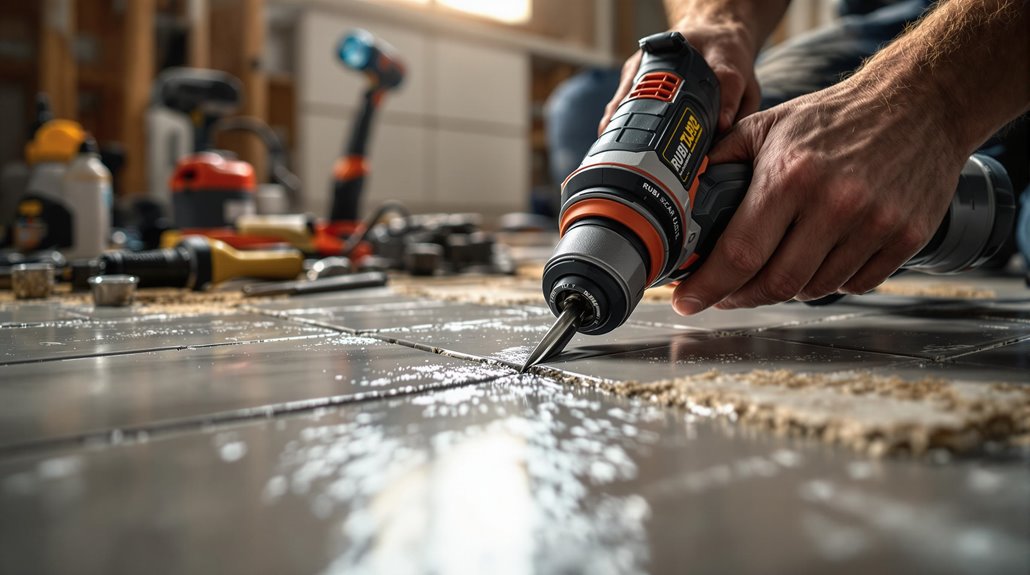
In cases where extensive water damage persists beneath tiles, removal of tiles and grout becomes necessary for complete moisture remediation.
Several grout removal techniques can be employed while maintaining proper tile protection methods throughout the process.
- Chemical grout strippers and acid cleaners offer effective removal but require careful application to prevent tile damage.
- Mechanical approaches using hardwood or wire wool provide controlled removal with minimal risk to surrounding tiles.
- Power tools like oscillating multitools with carbide-grit blades enable precise grout removal in targeted areas.
- Specialized tools such as the RUBI Scraper or Grout Grabber facilitate efficient removal while maintaining tile integrity.
For ideal results, technicians should select the most appropriate method based on the extent of water damage, grout type, and tile material composition.
Preventing Future Water Damage
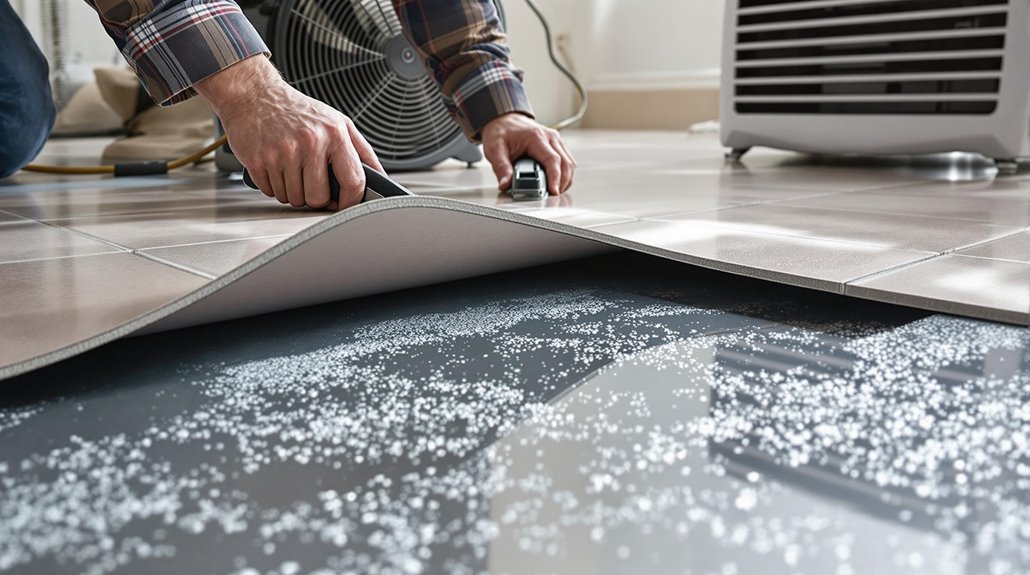
Effective prevention of water damage beneath tiles requires a thorough approach that combines proper material selection, waterproofing techniques, and regular maintenance protocols. Implementing water resistant materials like porcelain tiles and epoxy grout creates a durable foundation, while effective waterproofing through sheet or liquid-applied membranes provides essential protection against moisture penetration.
| Prevention Element | Implementation Strategy | Key Benefits |
|---|---|---|
| Material Selection | Porcelain/ceramic tiles, epoxy grout | Enhanced durability |
| Waterproofing | Sheet/liquid membranes | Moisture barrier |
| Maintenance | Regular inspections, sealing | Long-term protection |
Regular maintenance, including prompt spill cleanup and periodic grout sealing, guarantees the longevity of these protective measures. Professional installation of waterproofing systems and proper sealing techniques greatly reduce the risk of future water-related issues.
Health and Safety Precautions

While preventive measures safeguard against water damage, addressing the health and safety risks associated with wet tiles requires careful consideration and specific precautions.
Professional assessment of potential hazards guarantees effective remediation and risk mitigation. For mold prevention, immediate action to dry affected areas prevents spore proliferation and associated respiratory issues.
Electrical safety demands inspection of wiring near wet zones to prevent shock hazards.
- Wear appropriate protective gear, including respirators and gloves, when handling potentially moldy areas
- Guarantee proper ventilation during drying and remediation processes
- Disconnect power to affected areas until a qualified electrician confirms safety
- Restrict access to wet zones to prevent slip-and-fall accidents
These precautions protect occupants while addressing water issues, guaranteeing both effective remediation and personal safety during the drying process.
Long-Term Maintenance Strategies

Maintaining tiled surfaces demands a systematic approach to prevent water-related issues and extend flooring longevity. Regular inspection protocols should include monitoring grout lines, checking for hollow spots, and evaluating plumbing systems for potential leaks that could compromise long term durability.
Implementation of moisture resistant materials plays a vital role in prevention. This includes utilizing epoxy grout, applying protective sealants, and installing waterproofing membranes beneath tile surfaces.
Professional installation guarantees proper substrate preparation and material application.
Ongoing maintenance requires periodic sealing of grout lines, immediate cleanup of water spills, and regular testing of water chemistry in areas near pools or water features.
These preventive measures, combined with routine inspections and prompt repairs, create an extensive strategy for protecting tiled surfaces and maintaining their structural integrity over time.
The Benefits Of Consulting A Public Adjuster
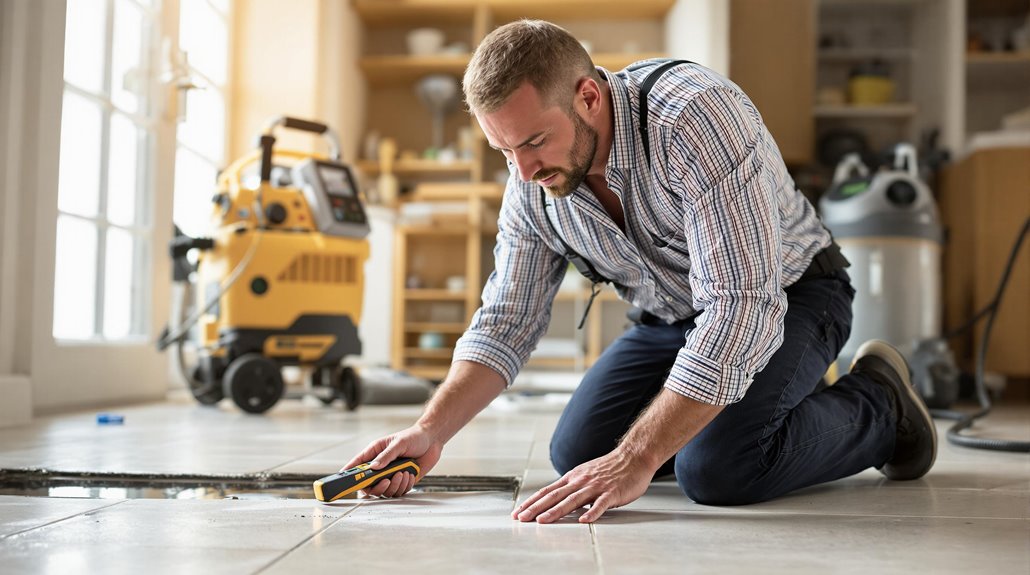
Professional public adjusters bring specialized expertise in managing water damage insurance claims, conducting thorough assessments of both visible and hidden tile damage through advanced inspection methods.
Their objective evaluations and extensive documentation streamline the claims process while ensuring all damage is properly cataloged and addressed.
Studies indicate that claims handled by public adjusters typically result in higher settlements, providing property owners with adequate compensation for proper remediation and restoration.
Working on a contingency fee basis, public adjusters charge between 5-20% of the final settlement amount while helping reduce stress for property owners during the claims process.
Expertise In Insurance Claims
Consulting a public adjuster can greatly improve the outcome of water damage insurance claims for affected tile floors. Their expertise in insurance policy understanding and claims process navigation guarantees policyholders receive maximum benefits for water-related tile damage.
Public adjusters possess the technical knowledge to interpret complex policy terms and handle intricate documentation requirements.
Key services provided by public adjusters include:
- Thorough policy interpretation and analysis of coverage for water damage
- Professional documentation of tile damage, moisture levels, and repair estimates
- Expert negotiation with insurance companies for fair settlements
- Management of paperwork and claim submission procedures
Working on a contingency basis, public adjusters are motivated to secure advantageous settlements. Their professional expertise typically results in higher compensation compared to policyholder-managed claims, making their services valuable for significant water damage incidents affecting tile flooring. Studies have shown that claims handled by licensed public adjusters can result in settlements up to 500% higher for non-catastrophic water damage incidents.
Objective Damage Assessment
An objective damage assessment by a public adjuster provides critical insights into water-damaged tile floors through advanced diagnostic tools and methodical evaluation procedures.
Using specialized moisture meters and thermal imaging equipment, adjusters conduct thorough damage evaluation to detect hidden water accumulation beneath tiles and within surrounding structures.
Professional adjusters employ systematic inspection protocols, documenting both visible and concealed damage patterns. This detailed moisture detection process reveals the full extent of water infiltration, potential structural compromises, and risks of mold development.
Through aerial drone surveys and detailed photographic evidence, adjusters create a complete assessment portfolio that strengthens insurance claims and guarantees proper compensation for all affected areas.
This methodical approach helps counter insurance company minimization tactics while establishing an accurate representation of the total damage scope.
Public adjuster fees typically range from 5% to 15% of the final settlement amount but often result in significantly higher compensation for water damage claims.
Streamlined Claim Process
Working with a public adjuster greatly streamlines the water damage claims process through automated documentation systems and optimized workflows. Claims automation reduces processing time while enhancing accuracy in damage assessment documentation. Document efficiency eliminates manual errors and guarantees consistent data validation throughout the claim lifecycle. Independent repair estimates can strengthen your negotiating position during the claims assessment process. Real-time updates provide transparent status tracking and immediate access to claim information. Automated document generation accelerates processing of forms, letters, and required paperwork. Digital validation systems verify completeness and accuracy of submitted documentation. Streamlined communication channels enable faster response times and resolution. This systematic approach minimizes administrative burden while maximizing claim settlement efficiency. The result is a more accurate, faster claims process that reduces disputes and accelerates payment disbursement for water damage repairs.
Higher Claim Payouts & Settlements
Public adjusters consistently secure higher claim settlements through their expert damage assessment capabilities and negotiation skills. Their thorough property evaluations guarantee all water damage beneath tiles is properly documented and accurately estimated, maximizing the potential claim value.
Through skilled claim negotiation and proven settlement strategies, public adjusters leverage their in-depth knowledge of insurance policies to advocate for top compensation. They understand insurance company tactics and can effectively counter attempts to minimize payouts.
Working on a contingency basis, they are incentivized to secure the highest possible settlements while eliminating out-of-pocket expenses for property owners. Their professional representation removes emotional bias from negotiations, guaranteeing objective claim handling and compliance with policy requirements, ultimately resulting in more favorable settlement outcomes for policyholders.
Unlike insurance adjusters who focus on minimizing company costs, public adjusters conduct comprehensive damage assessments to identify all losses, including hidden damages that might otherwise go unnoticed.
About The Public Claims Adjusters Network (PCAN)
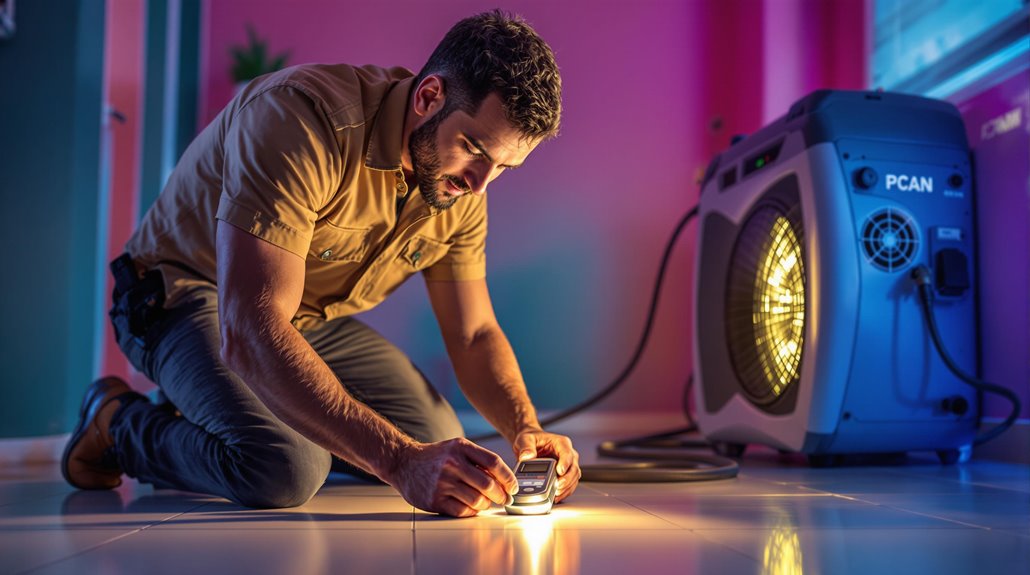
The Public Claims Adjusters Network (PCAN) stands as an extensive alliance of independent claims adjusters who specialize in managing diverse insurance claims. With decades of combined Claims Management Expertise, PCAN delivers thorough solutions from initial loss notification through final settlement.
The Public Adjuster Benefits include immediate support and ideal claim outcomes through their professional network.
Key components of PCAN's service delivery include:
- Dedicated call center providing instant support for first notice of loss
- Specialized adjusters for both routine and catastrophic claims
- Customized solutions tailored to each unique claim scenario
- Detailed claim lifecycle management with proven expertise
PCAN's strategic approach combines professional standards with empathetic service, setting new benchmarks in the claims management industry while ensuring client satisfaction through every phase of the process.
Frequently Asked Questions
Can I Speed up Drying by Drilling Small Holes in Grout Lines?
Drilling gr
How Long Should I Wait Before Walking on Tiles After Drying?
For ideal walking surface safety, allow 24-72 hours before traversing newly laid tiles. Rapid-set adhesives permit foot traffic after 6 hours, while traditional thinset requires the full tile drying timeline.
Will Water Under Tiles Always Cause Visible Damage to Surrounding Walls?
Water damage under tiles doesn't always cause visible wall damage. Factors like waterproofing, ventilation, wall materials, and proper tile maintenance determine whether moisture penetration becomes apparent on surrounding surfaces.
Does Homeowner's Insurance Typically Cover Water Damage Under Tiles?
Standard insurance policies typically cover sudden, accidental water damage claims under tiles, but exclude gradual leaks, poor installation, or maintenance issues unless they result in additional consequential damage.
Can Different Types of Tile Material Affect the Drying Time?
Like sponges of varying densities, different tiles absorb moisture uniquely. Ceramic and porcelain tiles dry quickly within hours, while natural stone tiles require up to 24 hours, affecting overall drying time markedly.
References
- https://www.couchpotatocarpet.com/blog/articles/water-under-your-laminate-flooring-dont-panic-heres-how-to-dry-it
- https://serviceteam.co.uk/signs-of-water-leaks-under-tiles/
- https://wac.colostate.edu/docs/books/writingspaces1/writing-spaces-readings-on-writing-vol-1.pdf
- https://www.youtube.com/watch?v=InB2zZOHY24
- https://ctasc.com/expert-answers/why-is-water-suddenly-seeping-through-my-tile-grout-joints/
- https://www.1tomplumber.com/signs-water-damage-under-tile/
- https://www.youtube.com/watch?v=AA8atc7YqIs
- https://tilecentralcoast.com/water-flooding-tile-floor/
- https://www.thegroutguy.com.au/blog-posts/how-to-spot-water-damage-underneath-your-shower-tiles/
- https://foundation-crack-expert.com/how-to-detect-water-leaks-under-the-tiles/
